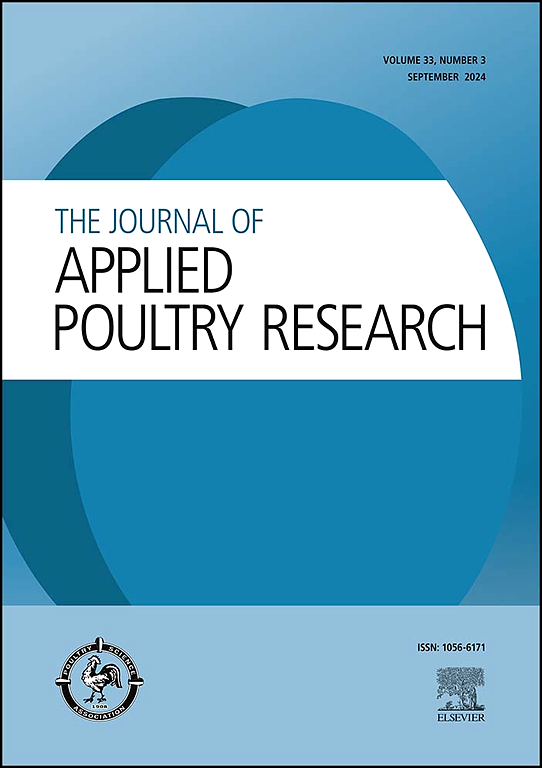An AHP-multiple logistic regression model for risk assessment of highly pathogenic avian influenza
IF 2
3区 农林科学
Q2 AGRICULTURE, DAIRY & ANIMAL SCIENCE
引用次数: 0
Abstract
Quantitative risk assessment of highly pathogenic avian influenza (HPAI) is crucial to timely formulate and adjust effective prevention and control strategies for epidemic prevention agencies. However, the risk assessment models based on risk level classification are very few. This study established a quantitative risk assessment model for early risk warning of HPAI. Through collecting data on reported cases of HPAI from July 2007 to July 2022, the outbreak characteristics of HPAI were analyzed in terms of the outbreak time, virus subtype, and outbreak location. The risk factor weights were determined by the analytic hierarchy process (AHP), and the risk levels of HPAI reports were quantified using a multi-indicator composite score. Results showed that the highest frequency of HPAI outbreaks were from November to April. H5N8 and H5N1 subtypes were the most susceptible accounting for 48.3 % and 30.9 % of outbreaks, respectively. H5N3, H5N9, H7N2, and H7N1 subtypes had the highest mortality of about 100 %. Chinese Taipei, France, Germany, Hungary, and Nigeria had the largest number of HPAI reports over the past decade, which had more than 500 reports. The risk assessment model based on AHP-multiple logistic regression was built with an accuracy rate of 93.3 %. The quantitative analysis showed that R ≥ 0, −0.4 ≤ R < 0, −0.6 ≤ R < −0.4, and R < −0.6 could be used to classify as four risk levels of significant, high, medium, and low, respectively. The comparison showed that the Monte Carlo simulation risk assessment model based on @Risk software couldn't satisfy the requirements of HPAI data analysis due to the crossed risk ranking thresholds and inaccurate risk ranking. Therefore, the risk assessment model based on AHP-multiple logistic regression can be used to assess the risk of HPAI occurrence, which has advantages including the operable method, the accurate evaluation of the epidemic situation, and the risk factors significantly correlated to risk results.
高致病性禽流感风险评估的ahp -多元logistic回归模型
对高致病性禽流感(HPAI)进行定量风险评估,是疫情防控机构及时制定和调整有效防控策略的重要依据。然而,基于风险等级分类的风险评估模型很少。本研究建立了高致病性禽流感早期风险预警的定量风险评估模型。通过收集2007年7月至2022年7月报告的高致病性禽流感病例资料,从暴发时间、病毒亚型和暴发地点等方面分析高致病性禽流感的暴发特征。采用层次分析法(AHP)确定风险因子权重,采用多指标综合评分法量化HPAI报告的风险水平。结果显示,11月至次年4月为高致病性禽流感暴发高峰期。H5N8和H5N1亚型最易感,分别占疫情的48.3%和30.9%。H5N3、H5N9、H7N2和H7N1亚型的死亡率最高,约为100%。中国台北、法国、德国、匈牙利和尼日利亚在过去十年中报告的高致病性禽流感病例最多,有500多例报告。建立了基于ahp -多元logistic回归的风险评估模型,准确率为93.3%。定量分析表明,R≥0,- 0.4≤R <;0,−0.6≤R <;−0.4,R <;−0.6可分别分为显著、高、中、低四个风险等级。对比表明,基于@Risk软件的蒙特卡罗模拟风险评估模型存在风险排序阈值交叉、风险排序不准确等问题,不能满足HPAI数据分析的要求。因此,基于ahp -多元logistic回归的风险评估模型可用于高致病性禽流感发生风险评估,具有方法可操作性强、疫情评估准确、风险因素与风险结果显著相关等优点。
本文章由计算机程序翻译,如有差异,请以英文原文为准。
求助全文
约1分钟内获得全文
求助全文
来源期刊

Journal of Applied Poultry Research
农林科学-奶制品与动物科学
CiteScore
4.10
自引率
10.50%
发文量
80
审稿时长
104 days
期刊介绍:
The Journal of Applied Poultry Research (JAPR) publishes original research reports, field reports, and reviews on breeding, hatching, health and disease, layer management, meat bird processing and products, meat bird management, microbiology, food safety, nutrition, environment, sanitation, welfare, and economics. As of January 2020, JAPR will become an Open Access journal with no subscription charges, meaning authors who publish here can make their research immediately, permanently, and freely accessible worldwide while retaining copyright to their work. Papers submitted for publication after October 1, 2019 will be published as Open Access papers.
The readers of JAPR are in education, extension, industry, and government, including research, teaching, administration, veterinary medicine, management, production, quality assurance, product development, and technical services. Nutritionists, breeder flock supervisors, production managers, microbiologists, laboratory personnel, food safety and sanitation managers, poultry processing managers, feed manufacturers, and egg producers use JAPR to keep up with current applied poultry research.
 求助内容:
求助内容: 应助结果提醒方式:
应助结果提醒方式:


